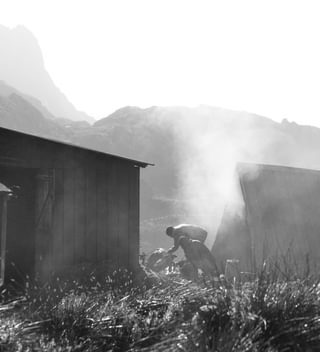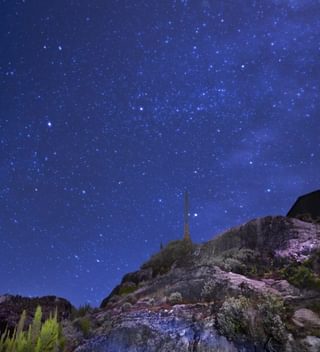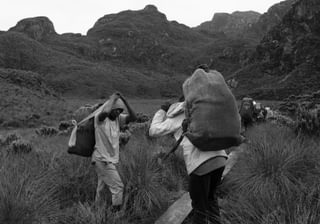Holly Budge - Margherita Peak Trek - FAQs
Holly Budge Margherita Peak Trek - FAQs

Join Holly Budge for a 15-day trip around Uganda which will see you climb Mount Stanley to reach Margherita Peak, take a game drive in Queen Elizabeth National Park and trek to see rare mountain gorillas.
Dates: March 26th - April 9th 2023

Tell me more about Holly Budge
With a decade of mountaineering under her belt and much time spent patrolling on the front lines with ranger teams in Africa, Holly Budge will inspire you to think big and dream bigger. As the founder and leader of international NGO, How Many Elephants, her work has been celebrated by Sir David Attenborough. As a keynote speaker, she is described as “down-to-earth, funny and incredibly inspiring” by HRH Prince Edward. Holly has raised over £400,000 for environmental projects.
Do I need climbing experience to join?
Mount Stanley is the highest mountain in Uganda and the third-highest in Africa. Margherita Peak is the highest point - reaching a staggering 5,109 metres. While almost 800m shy of Kilimanjaro, it is a more technical climb - and much less crowded.
Whilst you don’t have to be an experienced mountaineer to climb Mount Stanley as you will have fully qualified guides leading you up, some experience of using crampons will be helpful as the summit push involves some ice-hiking.
You need to have a good level of physical fitness as the hike to Mount Stanley involves long days at altitude, passing through some challenging terrain with some very steep parts.


How many people will be on the trip?
The trip will be a small group of 8 people, plus Holly Budge who will accompany you throughout the trip. Keeping the group small gives you plenty of access to spend with Holly - you'll find her enthusiasm and passion infectious. Holly has been a keynote speaker for BBC news, North Face and the Economist to name a few; she is sure to inspire you beyond climbing Mount Stanley and give you plenty to think about when you return home! She's also a brilliant raconteur with plenty of adrenaline-filled stories up her sleeve....
Can I have full details of the climb?
Of course! A day by day itinerary including how high you are climbing each day is below.
Day 1 of the trek: Trekkers hostel Kilembe the base camp at 1450 meters
Start at Trekkers at 1,450 meters and sleep at Sine Hut at 2,596 meters being a height gain of 1,146 meters.
We start by walking up the valley floor through tall forest trees of the Afro Montane Forest Zone. This is a steady climb with multitudes of birds and a chance of seeing blue monkeys scampering off through the forest. At times visitors may see troupes of 15 to 20 black and white Colobus monkeys as they swing through the treetops. There are rare sightings of the L’Hoest monkey which are part of the Bukonzo cultural emblems and are protected by the virtue of the King or Omusinga or you may hear wild chimpanzee in the distance. There is a wide variety of plant species from forest trees to bamboo thickets, low shrubs, flowers, fungi, and many moss and lichen-covered vines hanging from the tall trees creating an awesome appeal. Enock’s Falls are just 200 meters from Sine Hut and offer a splendid opportunity to capture a great screensaver for your memories.
At Sine Camp 2,596 metres there are wooden huts set between tall forest trees on a narrow ridge where you may sit and enjoy the beauty of the Afro Montane forest while you look down at a fantastic waterfall crashing over the rocks far below. Some clients prefer to sit outside enjoying the warmth of the campfire and chat with the guides about the mountains and life in their community. Sine is just below the bamboo zone and the area around has many different bird species. 150 meters from the camp is Enock falls which are set in livid green vegetation and hanging vine. Truly beautiful.
Sleep at Sine Camp, or those who are fit and want to proceed to Kalalama Camp at 3,134 metres may do so which gives you more time at Mutinda Camp where you may climb up to Mutinda Lookout at 3,975 metres.



Day 2 of trek: Hike to Mutinda Camp at 3588 Meters,
Trekking starts at 8.30 am and almost immediately you enter the Bamboo-Mimulopsis Zone which is a steep climb with many high steps. In the wet season, the bamboo zone is rather muddy and slippery making the going slow. However, the atmosphere and the forest are beautiful as you climb 551 metres altitude and a distance of 1.8km to Kalalama Camp at 3,147 meters which is in the Heather-Rapanea Zone where you can take a rest and a quick cup of tea or coffee before heading on to Mutinda Camp.
The trail meanders up and over several small knolls along a ridge top then drops down the side of the valley before climbing again, and in doing so crosses several small streams and passes close to moss covered waterfalls. You then climb steadily along the side of a beautiful mossy river which tumbles down over the rocks under the giant heather trees whose trunks are covered in green moss with old man beards (Usnea lichen) hanging from the branches. The trail twists and turns as you climb up the deep valley, which has an enormous variety of plants and flowers. This valley is unique with many giant heather trees creating a beautiful atmosphere often shrouded in mist.
In the afternoon you may wish to climb up to the top of the Mutinda Lookout (one to two hours up and one hour down) The views are amazing as you stand on moss-covered rocks at 3,925 meters with views across the Rwenzori Mountains and down to Kasese town and Lake George. Climbing Mutinda 3,975 meters is an excellent way to acclimatise and reduce the risk of high altitude sickness Sleep at Mutinda Camp at 3.582 metres.


Day 3 of trek: Hike to Bugata Camp at 4062 metres
The trail to Bugata Camp is boggy particularly in the wet season but with a little skill, you can step from tussock to tussock to make the going easier. First, you cross the Mutinda valley through the tussock grass and everlasting flowers interspersed with many Giant Lobelias before climbing a steep section up to the Namusangi Valley (3,840 meters), with sheer waterfalls and looking back you get fantastic views of Mutinda Peaks. The Namusangi Valley is wide, with many ups and downs as the trail climbs steadily to Bugata Camp at 4,100 metres.



Day 4 of trek: Hike to Hunwick’s Camp 3974 meters
Trek to Hunwick’s Camp via Bamwanjarra Pass. As you leave Bugata Camp you pass up a ridge and then drop down slightly before ascending to Bamwanjarra Pass at 4,450 meters where you have a hut in case the weather turns bad.
From the pass on a clear day, you get excellent views of the three main peaks. The trail passes down the valley and around the edge of some bogs. You are surrounded by thick evergreen vegetation and moss and will see giant groundsel and lobelia. Here is possibly the best place in all the Rwenzori to observe the Malachite Sunbird as it feeds on the many lobelia flowers, a known breeding site.
Further on there are some steep sections before a steady climb up and over a ridge to Hunwick's Camp which is situated on the top of a deep valley and has good views of Mt Stanley, Mt Baker, Weismanns Peak and McConnell’s Prong.


Day 5 of trek: Hike to Margherita Camp at 4485 Meters
From Hunwick's we pass down and across the valley floor to Lake Kitendara which is very stunning with deep water and beautiful vegetation. From here you climb up Scott Elliott's pass then up the ridge to Margherita Camp 4,485 metres which is situated between some huge rocks and offers some shelter from the strong winds. This is the very spot where the Duke of Abruzzi camped when making his climb to Margherita Peak in 1906.


Day 6 of trek:Summit of Margherita peak at 5109 meters- Descend to Hunwick’s Camp at 3.874 meters
Wake up at 2 am and catch an early breakfast before heading off to climb Mt Stanley at 2.30 am.
This is necessary as the weather has changed a lot and often even during the dryer season the mountain is closed in with heavy clouds and snow falls from 1 pm to 4 pm and this happens within a short period of 10 to 15 minutes as the clouds rise up from the extensive Congo rainforests.
During January and February 2017 clients were closed in and unable to walk during heavy snowstorms which previously were not heard of during the dryer season and arrived back at Margherita camp well after dark with one group arriving back at 11pm totally exhausted. Due to this change in weather, we have set a strict turnaround time of 10am so if you do not reach the peak before then you must turn around regardless of the disappointment in the interests of safety.
Margherita glacier has also suffered with global warming and as the outer edges of the glacier recede the ice is becoming steeper with one section of about 200 meters more than 60% grade. Combined with this much of the blacker has melted underneath causing caves under the ice which as it get thinner eventually caves in. So is necessary that clients understand and take advice of where the guides suggest to pass. For those clients with less mountaineering experience we suggest that you stay on Stanley glacier and climb up to a good vantage point on a rocky outcrop on the southern edge of Alexandra Peak to enjoy fantastic views over Congo and the lower mountain ridges After ascending the peak at 5,109 metres you then pass directly down to Hunwick's Camp at 3.874 metres.



Day 7 of trek: Descend down to Kiharo Camp at 3430 metres through Oliver’s pass
The distance to Kiharo Camp is11km and takes 4 to 7 hours to walk. From Hunwick’s Camp, we start the day by climbing up a ridge towards McConnell’s Prong where you get the best views of all three peaks and Scott Elliott’s Pass before reaching Oliver’s Pass at 4,505 metres. The distance from Hunwick’s Camp to the top of Olivers Pass is 3km. The trail then cuts across below Weismann’s Peak to the confluence of the Nyamwamba River which flows down through Kilembe and Kasese to Lake George in Queen Elisabeth National Park.
If you wish to climb Weismann's Peak which is 4,620 metres high from Oliver's pass, you may do so at an extra cost of $20 each. On a clear day, you get fantastic views of Margherita and Mt Stanley, Mt Speke and Mt Baker.
After crossing the confluence the trail meanders down the valley to Kiharo Camp at which is situated in a deep valley with high cliffs and dense vegetation. On the way down the valley after each bog you will climb over a ridge of stones and earth which seems out of place but actually was pushed there by slow-moving glaciers which eventually stopped moving, melted and left a pile of rocks and debris in front of where the glacier once stood.


Day 8 of trek: Descend downhill to base camp in Kilimbe.
The distance from Kiharo Camp to the park gate is 12.2km and then another 2.8km down to Trekkers Hostel Time. The walk time is 5 to 8 hours.
The trail down the Nyamwamba Valley is mostly downhill and absolutely stunning with beautiful views, moss-covered rocks along the river, cascading waterfalls, deep valleys and forests that are possibly the best in the Rwenzori Mountains. This part of the trail took guides six years to find a way through and a route which is easy enough for tourists to use.
In 1937 the explorer and geologist McConnell tried to find a way up this valley but failed and have to turn back and search for another route up the mountain now you can experience this truly beautiful valley.
A few kilometers from Kiharo Camp the path turns off to the right to pass along the river. In the clear areas you may catch a glimpse of a Duiker quietly feeding in small clearings as you pass along the river. If you wish you may prefer to walk down the river itself hopping across the rocks as you pass down. A few kilometres down the river it becomes very steep with multitudes of waterfalls so we have to move away from the river and follow a narrow ridge to bypass steep sections. At the bottom, we again meet the river where there is a huge rock shelter and a place to rest for a while. After crossing a small stream you climb up a gentle slope before turning back down to the river to avoid another set of waterfalls which are impassable. The forest along this section is magnificent and full of life with many birds, primates, dikers and hyrax. A great experience and ending to a fantastic trek.
On arrival at Trekkers Hostel will be picked up and transferred to Queen Elizabeth National Park, where you will stay overnight at Elephant Plains Lodge.


What gear is provided?
The following gear is provided: harnesses, carabiners, ice axes, helmets, rubber boots and ropes as part of the hiking package.
Will I see any elephants?
We hope so! There is an optional game drive in Queen Elizabeth's National Park the morning after your trek.
Queen Elizabeth National Park is the most popular place to see game in Uganda and is home to plenty of elephants, as well as lions, leopards and buffalo, meaning you could spot four of the Big Five.
What about mountain gorillas?
Absolutely! At Bwindi Impenetrable Forest, you will have a chance to spend time with the rare and critically endangered mountain gorillas, something which David Attenborough described as the greatest wildlife encounter on earth.
Along with a guide and tracker, you will get to spend an hour watching these magnificent animals eat, play, groom and socialise in their family. A truly humbling experience that will stay with you for life.

How does the trip link to How Many Elephants?
Holly has organized this trip to raise funds for her charity 'How Many Elephants' which is an anti-poaching charity raising awareness as to the devastating impact the ivory trade has on elephants. The charity is dedicated to helping rangers, with a particular focus on female rangers to effectively stop poaching and to raise awareness as to the amazing, and often dangerous work they do.
Holly is a huge advocate for female empowerment in the field of conservation in Africa and is the founder of World Female Ranger Week. During this trip, there will be opportunities to meet with female ranger guides in Uganda.































